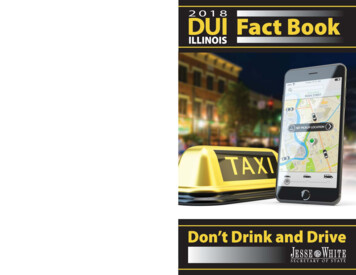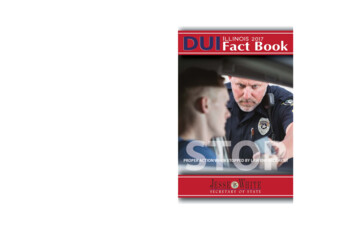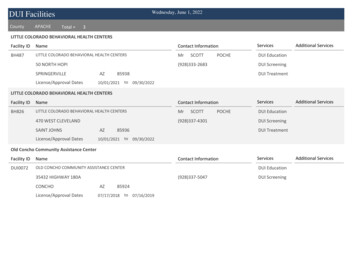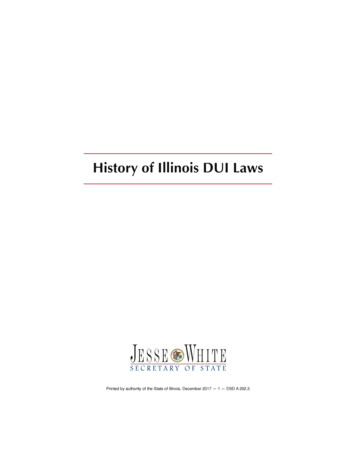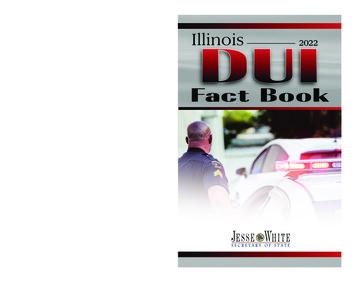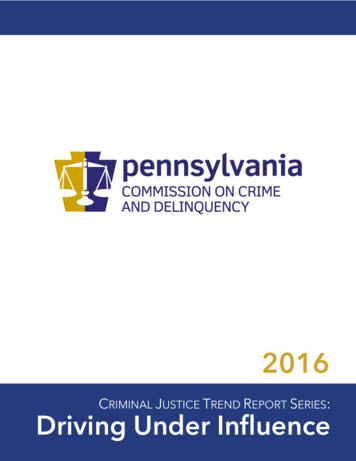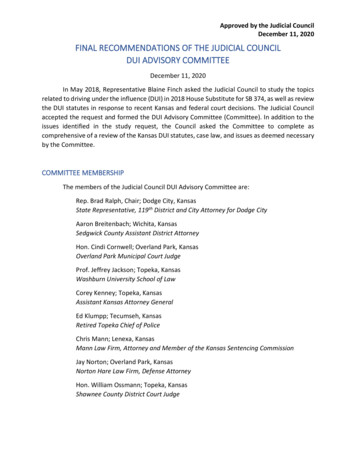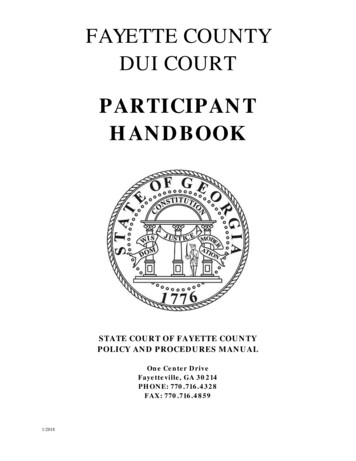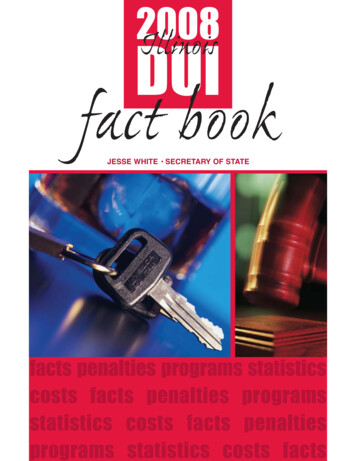
Transcription
2008IllinoisDUIfact bookJESSE WHITE SECRETARY OF STATEfacts penalties programs statisticscosts facts penalties programsstatistics costs facts penaltiesprograms statistics costs facts
A MESSAGE FROMSECRETARY OF STATE JESSE WHITEI am pleased to provide you this 2008 IllinoisDUI Fact Book, which contains information onIllinois’ continued efforts to combat drunk driving. In 2006, more than 17,000 people nationwide lost their lives in drunk driving crashes —the equivalent of one fatality every 31 minutes.My office continues to work with law enforcement, the legislature and the judiciary to keepdrunk drivers off the road. I am pleased to havesponsored legislation that requires any firsttime DUI offender to have a Breath AlcoholIgnition Interlock Device installed on his or hervehicle. The law takes effect Jan. 1, 2009, andwill serve as a strong deterrent for anyonethinking about getting behind the wheel afterdrinking.My office offers free copies of our award-winning DUI videos and public service announcements, as well as traffic safety speakers andpublications to educate the public about thedangers and consequences of drinking anddriving. To request a video, a speaker for yourschool or civic organization, or publications,please call the Traffic Safety Hotline at 866247-2013.I look forward to continuing my work in making Illinois roadways safe from drunk drivers.Jesse WhiteSecretary of State2008 DUIfact book
This edition of the DUI Fact Book is as accurate as possible atthe time of publication. This manual does not cover everyaspect of Illinois DUI laws and should not be cited as a legalauthority in court.Printed on recycled paper.Printed by authority of the State of Illinois. May 2008 — 15M — DSD A 118.11
Table of ContentsIllegal Blood-Alcohol Concentration (BAC) Limits in Illinois . . . . . . . . . . . . . .2Driving Under the Influence (DUI) . . . . . . . . . . . . . . . . . . . . . . . . . . . . . . . . . . .3Statutory Summary Suspension . . . . . . . . . . . . . . . . . . . . . . . . . . . . . . . . . . . . . .7Penalties for a DUI Conviction . . . . . . . . . . . . . . . . . . . . . . . . . . . . . . . . . . . . . .8Penalties for Other DUI-Related Offenses . . . . . . . . . . . . . . . . . . . . . . . . . . . . .13Administrative Driver’s License Revocation . . . . . . . . . . . . . . . . . . . . . . . . . . .15Judicial Hearings . . . . . . . . . . . . . . . . . . . . . . . . . . . . . . . . . . . . . . . . . . . . . . . .16Driving Permits . . . . . . . . . . . . . . . . . . . . . . . . . . . . . . . . . . . . . . . . . . . . . . . . .16Driver’s License Reinstatement . . . . . . . . . . . . . . . . . . . . . . . . . . . . . . . . . . . . .18Case Dispositions . . . . . . . . . . . . . . . . . . . . . . . . . . . . . . . . . . . . . . . . . . . . . . . .20Average Cost of a DUI Conviction in Illinois . . . . . . . . . . . . . . . . . . . . . . . . . .21Additional Costs Associated with a DUI, 2005-2006 . . . . . . . . . . . . . . . . . . . .21Penalties of Underage Drinking . . . . . . . . . . . . . . . . . . . . . . . . . . . . . . . . . . . . .22“Use It & Lost It”/Zero Tolerance Violations . . . . . . . . . . . . . . . . . . . . . . . . . .25Secretary of State DUI Programs . . . . . . . . . . . . . . . . . . . . . . . . . . . . . . . . . . . .27Victims’ Rights . . . . . . . . . . . . . . . . . . . . . . . . . . . . . . . . . . . . . . . . . . . . . . . . . .28Reporting of Injured Impaired Drivers . . . . . . . . . . . . . . . . . . . . . . . . . . . . . . .29History of Illinois DUI Laws . . . . . . . . . . . . . . . . . . . . . . . . . . . . . . . . . . . . . . .30Drivers Arrested for DUI, 2004-2006 . . . . . . . . . . . . . . . . . . . . . . . . . . . . . . . .38DUI FACT BOOK 1
Illegal BAC Limits in IllinoisDrivers under age 21. .00School bus drivers . .00Commercial driver’s license holders . .04Drivers age 21 and over. .08Number of drinks and BAC levelin ONE HOUR of drinkingBACMale — 170 poundsFemale — 137 pounds1 drink .54 ounces of pure alcohol*all contain an equivalentamount of alcohol{1 can of beer1 glass of wine1 shot of liquor* The amount of alcohol in a poured/mixed drink is dependent on the type of drink and the personwho pours it.2 DUI FACT BOOK
Driving Under the Influence (DUI)“Driving Under the Influence” is defined as operating a motor vehicle whileimpaired by alcohol, other drugs or intoxicating compounds. In Illinois, a driveris legally considered to be under the influence if he/she has a blood-alcohol concentration (BAC) of .08 or more, has used any illegal substance, or is impairedby medication. A driver’s BAC is based on the ratio of alcohol to blood or breath.However, an individual with a BAC between .05 and .08 may be convicted ofDUI if additional evidence determines that the driver was impaired. In 1997, theIllinois General Assembly passed legislation to lower the illegal BAC limit from.10 to .08. Illinois was the 15th state to impose such a change.The effect of alcohol on an individual is determined primarily by two factors: the amount ofalcohol consumed and the rate at which it isabsorbed by the body. Other contributing factors include gender, body weight, alcohol tolerance, mood, environment and the amount offood consumed.2006 BAC Levels of DriversWho Failed a Chemical Test.25- 6%.08-.098%.20-.2416%.10-.1435%From the first drink, alcohol affects coordinationand judgment. Even with a BAC well below .08,a person’s reaction time slows. The risk of being.15-.19in a crash begins to increase with a BAC between35%.04 and .05 and increases rapidly thereafter. By thetime a driver reaches a BAC of .06, he/she is twice as likely to be involved in a fatalcrash as a non-drinking driver. By the time a driver reaches a BAC of .08, he/she is 11times more likely to be killed in a single-vehicle crash than a non-drinking driver.The only way to rid the body of alcohol is time. Fresh air, coffee, a shower andfood cannot help a person become sober. It takes about one hour for the body tometabolize one drink. Each of the following has a comparable amount of alcoholand counts as one drink: one 12-ounce mug of beer, one 5-ounce glass of wine orone 1.5-ounce shot of hard liquor. (The amount of alcohol in a poured/mixeddrink is dependent on the type of drink and the person who pours it.)The average DUI offender is: male (80 percent arrested are men); age 34 (61 percent are under age 35); arrested between 11 p.m. and 4 a.m.on a weekend; and caught driving with a BAC of .16 —twice the illegal limit.— Illinois Secretary of StateDUI FACT BOOK 3
2006 Illinois DUI Facts 594 people were killed in alcohol-related crashes, which was 47 percent ofthe 1,254 total crash fatalities. More than 50,100 DUI arrests were recorded by the Secretary of State’soffice. 91 percent of all drivers arrested for DUI, who were eligible, lost their driving privileges. 2,663 drivers under age 21 lost their driving privileges due to “Use It & LoseIt” law violations. 19 percent of those arrested for DUI are women, who represent 50 percent ofall licensed drivers. Males ages 21-24 had the highest DUI arrest rate (about 27 per 1,000licensed drivers). This rate was four times greater than that of all other drivers arrested for DUI (6 per 1,000 licensed drivers). 83 percent of all drivers arrested for DUI are first offenders.2006 Illinois DUI Arrest 23.8693.3981.5931.1870.408016 & 17181920 21-24 25-34 35-44 45-54 55-64 65 & Drivers’ Ages at Time of ArrestNumber of arrests per 1,000 Licensed Drivers per Age Group4 DUI FACT BOOK
2006 National DUI Facts Alcohol-related crash fatalities in 2006 totaled 17,602 — the equivalent ofthree passenger cruise ships filled to capacity. Drivers with a BAC of more than .08 who were killed in crashes were 10times as likely to have a prior conviction for driving while intoxicated.Facts About .08 Illinois’ .08 illegal BAC limit was signed into law July 2, 1997. .08 is ameasurement of the blood-alcohol concentration level at which drivers areconsidered intoxicated and, therefore, are prohibited from driving on Illinoisroadways. All 50 states, the District of Columbia and Puerto Rico have .08 BAC per selaws. At .08, all drivers are impaired to the point that critical driving skills aregreatly diminished. Studies indicate that at .08, a driver’s steering, braking,speed control, lane changing, gear changing and judgments of speed and distance are all significantly impaired. To reach .08, a 170-pound male would have to consume four or more drinksin one hour on an empty stomach. A 137-pound female would have to consume three drinks in one hour to reach .08. A drink is considered a 12-ouncebeer, a 5-ounce glass of wine or a cocktail containing 1.5 ounces of 80-proofliquor. At .08, a driver is three times more likely to be involved in a car crash than asober driver, and 11 times more likely to be killed in a single-vehicle crash. About 80 percent of alcohol-related crash fatalities are caused by drivers withno arrests for drunk driving during the previous three years.In 2006, the average American was51 percent less likely to die in analcohol-related crash than in 1982.— National Highway TrafficSafety Administration (NHTSA)DUI FACT BOOK 5
Chronology of a DUI Arrest An officer stops a vehicle at a roadside safety check or for probable cause, reasonable suspicion or unusual operation. The officer observes the driver and requests a driver’s license, vehicle registration and insurance card. If the officer suspects the driver is under the influence, the driver is asked tosubmit to field sobriety tests. If the officer does not suspect the driver is under the influence, the driver isreleased with any applicable violations. If the officer has probable cause based on the field sobriety tests, the driver isplaced under arrest for DUI and taken to the police station. The driver is askedto submit to a chemical testing of breath, urine or blood. If the chemical test determines the driver is not under the influence, the driveris released with any applicable violations. If a tested driver’s BAC is more than .05 but less than .08 and no drugs arefound in the system, no Statutory Summary Suspension (see page 7) will apply;however, the associated DUI charge will remain until appropriate action istaken by the court. If the driver refuses to submit to or fails to complete testing, the StatutorySummary Suspension will apply. A repeat offender who refuses to submit totesting will not be eligible for a Restricted Driving Permit (RDP) during the 3year suspension. A repeat offender who takes the test and fails is not eligiblefor an RDP during the 1-year suspension. If the driver’s test results show a BAC of .08 or more, or any trace of a drug,illegal substance or intoxicating compound, the driver will be issued a lawenforcement sworn report notifying the driver of a Statutory SummarySuspension. If the driver’s license is valid, a receipt is issued allowing driving for 45 days. A driver may obtain additional testing at his/her own expense; the results areadmissible in court. The offender is required to post bond and may be detained until bond is posted. The offender’s vehicle may be towed, impounded or seized.The rate of alcohol impairmentamong drivers involved in fatal crashes is four times higher at night thanduring the day.— NHTSA6 DUI FACT BOOK
Statutory Summary SuspensionA Statutory Summary Suspension provides for the automatic suspension of drivingprivileges of a driver arrested for DUI who fails, refuses to submit to, or fails to complete chemical testing. Failure of chemical testing means a person’s BAC was .08 ormore or the test showed a trace of other drugs. Statutory Summary Suspensions areautomatic, effective on the 46th day from the date of the suspension notice. This suspension does not replace criminal penalties for a DUI conviction. An offender mayrequest a judicial hearing to challenge the arrest; however, the request does not stopthe suspension from taking effect. If an Illinois driver refuses to submit to chemicaltesting in another state, his/her driving privileges will be suspended. A StatutorySummary Suspension does not apply to a person with a BAC of less than .08. Ifa person has a BAC of more than .05, and additional evidence such as an opencontainer warrants a DUI arrest, the outcome of the court case will determine ifpenalties apply. If a commercial driver’s license holder receives a StatutorySummary Suspension, his/her CDL privileges will be suspended for one year fora first offense; a lifetime suspension applies for a second offense.Failing Chemical Testing First offense — Suspension of driving privileges for 3 months (eligible forJDP on 31st day of suspension).* Second or subsequent offense within 5 years — Suspension of driving privileges for 1 year (not eligible for driving relief).Refusing to Submit to Chemical Testing First offense — Suspension of driving privileges for 6 months (eligible forJDP on 31st day of suspension).* Second or subsequent offense — Suspension of driving privileges for 3 years(not eligible for driving relief).* Effective Jan. 1, 2009, a Monitoring Device Driving Permit will replace the JudicialDriving Permit. Also, the suspension period for a first offense for failing chemical testing will increase to 6 months; the suspension period for a first offense for refusing tosubmit to chemical testing will increase to 12 months. A first-time DUI offender whowishes to obtain and is eligible for driving relief during the suspension period musthave a Breath Alcohol Ignition Interlock Device (BAIID) installed on his/her vehicle.In 2006, 91 percent of drivers arrestedfor DUI who refused to submit to orfailed chemical testing lost their drivingprivileges; 83 percent of those were firstoffenders.— Illinois Secretary of StateDUI FACT BOOK 7
Penalties for a DUI ConvictionDriving Under the Influence (DUI)Penalties for DUI in Illinois vary depending on the circumstances of the arrestand conviction. These circumstances may include the driver’s age, the driver’sBAC level, whether the driver was transporting a child under age 16, and whetherthe driver has previous DUI convictions. Effective June 1, 2008, any DUI offenseresulting in felony charges is classified as Aggravated DUI.First ConvictionClass A misdemeanor (possible imprisonment of up to 1 year; fines of up to 2,500); minimum revocation of driving privileges for 1 year (2 years if driver isunder age 21); revocation of vehicle registration. If committed with a BAC of .16 or more — In addition to any penalties orfines, mandatory minimum fine of 500 and mandatory minimum 100 hours ofcommunity service. If committed while transporting a child under age 16 — In addition to anypenalties or fines, possible imprisonment of up to 6 months, mandatory minimum fine of 1,000 and 25 days of community service in a program benefitingchildren. If committed while transporting a child under age 16 and involved in a crashthat resulted in bodily harm to the child (Aggravated DUI); Class 4 felony (possible imprisonment of 1-3 years, fines of up to 25,000) — In addition to anyother criminal or administrative sanctions, mandatory fine of 2,500 and 25days of community service in a program benefiting children.Second ConvictionClass A misdemeanor (possible imprisonment of up to 1 year; fines of up to 2,500); mandatory minimum imprisonment of 5 days or 240 hours of community service; revocation of driving privileges for a minimum of 5 years for a secondconviction within 20 years; revocation of vehicle registration. If committed with a BAC of .16 or more — In addition to any penalties orfines, mandatory imprisonment of 2 days and mandatory minimum fine of 1,250. If committed while transporting a child under age 16 (Aggravated DUI); Class4 felony (possible imprisonment of 1-3 years, fines of up to 25,000). If committed while transporting a child under age 16 and involved in a crashthat resulted in bodily harm to the child (Aggravated DUI); Class 2 felony (possible imprisonment of 3-7 years, fines of up to 25,000) — In addition to anyother criminal or administrative sanctions, mandatory fine of 5,000 and 25days of community service in a program benefiting children.8 DUI FACT BOOK
Third Conviction (Aggravated DUI)Class 2 felony (possible imprisonment of 3-7 years, fines of up to 25,000); revocation of driving privileges for a minimum of 10 years; revocation of vehicleregistration. If committed with BAC of .16 or more — In addition to any other criminal oradministrative sanctions, mandatory imprisonment of 90 days and mandatoryminimum fine of 2,500. If committed while transporting a child under age 16 — In addition to any othercriminal or administrative sanctions, mandatory fine of 25,000 and 25 days ofcommunity service in a program benefiting children.Fourth Conviction (Aggravated DUI)Class 2 felony (possible imprisonment of 3-7 years, fines of up to 25,000); revocation of driving privileges for life with no relief available; revocation of vehicle registration. If committed with a BAC of .16 or more — In addition to any other criminalor administrative sanctions, mandatory minimum fine of 5,000. If committed while transporting a child under age 16 — In addition to any othercriminal or administrative sanctions, mandatory fine of 25,000 and 25 days ofcommunity service in a program benefiting children.Fifth Conviction (Aggravated DUI)Class 1 felony (possible imprisonment of 4-15 years, fines of up to 25,000); revocation of driving privileges for life with no relief available; revocation of vehicle registration. If committed with a BAC of .16 or more — In addition to any other criminalor administrative sanctions, mandatory minimum fine of 5,000. If committed while transporting a child under age 16 — In addition to any othercriminal or administrative sanctions, mandatory fine of 25,000 and 25 days ofcommunity service in a program benefiting children.Sixth or Subsequent Conviction (Aggravated DUI)Class X felony (possible imprisonment of 6-30 years, fines of up to 25,000);revocation of driving privileges for life with no relief available; revocation ofvehicle registration. If committed with a BAC of .16 or more — In addition to any other criminalor administrative sanctions, mandatory minimum fine of 5,000. If committed while transporting a child under age 16 — In addition to any othercriminal or administrative sanctions, mandatory fine of 25,000 and 25 days ofcommunity service in a program benefiting children.DUI FACT BOOK 9
Aggravated DUIEffective June 1, 2008, any DUI offense resulting in felony charges is classifiedas Aggravated DUI. Any mandatory term of imprisonment or community serviceis not subject to suspension or reduction. Any person sentenced to probation orconditional discharge also must serve a minimum 480 hours of community service or 10 days imprisonment.Aggravated DUI includes the following offenses: Third or subsequent DUI (Class 4-X felony; penalties vary according to offense— see pages 8-9). DUI committed while driving a school bus carrying persons age 18 or younger(Class 4 felony, imprisonment of 1-3 years, fines of up to 25,000). DUI resulting in great bodily harm, permanent disability or disfigurement(Class 4 felony, imprisonment of 1-12 years, fines of up to 25,000).Revocation of driving privileges for a minimum of 2 years. Second or subsequent DUI committed while transporting a child under age 16(Class 4-X felony; penalties vary according to offense). DUI committed while transporting a child under age 16 and involved in a crashthat resulted in bodily harm to the child (Class 4-X felony; penalties varyaccording to offense). DUI committed without a valid driver’s license or permit (Class 4 felony,imprisonment of 1-3 years, fines of up to 25,000). DUI committed without vehicle liability insurance (Class 4 felony, imprisonment of 1-3 years, fines of up to 25,000). Second DUI committed after a previous conviction for reckless homicide whileDUI or Aggravated DUI involving a death (Class 4 felony, 1-3 years of imprisonment, fines of up to 25,000). DUI committed in a school zone while the restricted speed limit is in effect andinvolved in a crash that resulted in bodily harm (Class 4 felony, imprisonmentof 1-3 years, fines of up to 25,000). DUI committed while revoked or suspended for DUI, reckless homicide orleaving the scene of a personal injury or death (Class 4 felony, imprisonmentof 1-3 years, fines of up to 25,000). Any penalty imposed is in addition to thepenalty for any subsequent DUI violation. Revocation period determined byoffense. DUI resulting in death (Class 2 felony, imprisonment of 3-14 years; 6-28 yearsif more than one death; fines of up to 25,000). Revocation of driving privileges for a minimum of 2 years from the effective date of the revocation orfrom the date of release from incarceration for the offense.10 DUI FACT BOOK
Additional Consequences of DUI A DUI conviction is a permanent part of an offender’s driving record. The offender may lose work time. The offender is required to complete an alcohol/drug evaluation and an alcohol/drug remedial education course or substance abuse treatment programbefore driving privileges are reinstated. The offender must meet the requirements of the Secretary of State’s Departmentof Administrative Hearings prior to obtaining an RDP (see page 17). The offender’s vehicle may be impounded or seized. A BAIID may be installed in the offender’s vehicle as a condition of drivingrelief. The offender is required to carry high-risk auto insurance for 3 years. The offender’s vehicle registration will be suspended or revoked.The DUI criminal charge is prosecuted and adjudicated in the courts. This chargeis separate from the Statutory Summary Suspension, which is an administrativeprocess. A person convicted of DUI whose driving privileges were suspendedbecause of a Statutory Summary Suspension will have that time credited to theminimum period of revocation of driving privileges.If a driver is convicted of DUI in another state, the conviction will be added tohis/her Illinois driving record and result in revocation of driving privileges.In 2006, 15 percent of all driversinvolved in fatal crashes during theweek were alcohol-impaired comparedto 31 percent on weekends.— NHTSADUI FACT BOOK 11
Penalties for Other DUI-Related OffensesPossession of Drugs in a VehicleIllegal possession of a controlled substance or cannabis by a driver; violationsmust be entered in court records and reported to the Secretary of State. First conviction — Suspension of driving privileges for 1 year. Second conviction within 5 years — Suspension of driving privileges for 5years.Knowingly Permitting a DriverUnder the Influence to Operate a Vehicle Class A misdemeanor; possible imprisonment of up to 1 year; fines of up to 2,500.Driving on a Suspended or Revoked License First conviction — Class A misdemeanor; possible imprisonment of up to 12months; mandatory imprisonment of 10 days in jail or 30 days of community service; fines of up to 2,500; suspension of driving privileges for double the originalsuspension period or additional revocation of 1 year; may result in seizure or forfeiture of vehicle. Second conviction — Class 4 felony; possible imprisonment of 1-3 years; minimum 30 days in jail or 300 hours of community service; fines of up to 25,000;suspension of driving privileges for double the original suspension period oradditional revocation of 1 year; may result in seizure or forfeiture of vehicle. Third conviction — Class 4 felony; possible imprisonment of 1-3 years; minimum 30 days in jail or 300 hours of community service; fines of up to 25,000;suspension of driving privileges for double the original suspension period oradditional revocation of 1 year; may result in seizure or forfeiture of vehicle. Fourth through ninth conviction — Class 4 felony; possible imprisonment of1-3 years; minimum 180 days in jail; fines of up to 25,000; suspension of driving privileges for double the original suspension period or additional revocation of 1 year; may result in seizure or forfeiture of vehicle. 10th through 14th conviction — Class 3 felony; possible imprisonment of 2-5years; not eligible for probation or conditional discharge; fines of up to 25,000;suspension of driving privileges for double the original suspension period orOf the driver’s license revocations in2006, 3,471 were for second offenses,1,023 were for third offenses, and 509were for fourth or subsequent offenses,which resulted in a lifetime revocation.— Illinois Secretary of State12 DUI FACT BOOK
additional revocation of 1 year; may result in seizure or forfeiture of vehicle. 15th or subsequent conviction — Class 2 felony; possible imprisonment of 3-7years; not eligible for probation or conditional discharge; fines of up to 25,000;suspension of driving privileges for double the original suspension period oradditional revocation of 1 year; may result in seizure or forfeiture of vehicle.Dram ShopAn employee or owner of an establishment may be held liable for a crash resulting from the unlawful selling, giving or delivery of alcohol in that establishmentto a minor, intoxicated person or person known to be under legal disability or inneed of mental treatment. Liability is limited to 50,467 for property damage or personal injury. Liability extends to 61,682 for a loss of means of support due to death or injury.Illegal Transportation/Open ContainerIt is illegal to transport, carry, possess or have any alcoholic beverages in the passenger compartment of a motor vehicle, except in the original container with theseal unbroken. Limousines, motor homes, mini motor homes and chartered busesnot hired for school purposes are exceptions to the law. Maximum fine of 1,000 and points-assigned violation on driver’s record. Suspension of driving privileges for 1 year or revocation for a second conviction within 1 year. If the offender is under age 21 — Mandatory suspension of driving privilegesfor 1 year for first offense; mandatory revocation of driving privileges for asecond offense.Illegal Transportation Convictions10,000TOTAL9,933UNDER 021,0172003817200481820057642006DUI FACT BOOK 13
Fraudulent IDs and Driver’s LicensesIt is illegal to assist in obtaining or to fraudulently obtain, distribute, use or possess a fraudulent state ID card or driver’s license. The Secretary of State has theauthority to suspend or revoke driving privileges for up to one year without a conviction for anyone involved in the following offenses:Class A misdemeanors (subsequent offenses are Class 4 felonies) Possessing, attempting to obtain or assisting another in obtaining a fraudulentdriver’s license or permit (first offense). Allowing another person to use your driver’s license or permit. Displaying or representing as one’s own any driver’s license or permit issuedto someone else. Allowing any unlawful use of one’s driver’s license or permit.Class 4 felonies (subsequent offenses may be Class 3 felonies) Possessing, attempting to obtain or assisting another in obtaining a fraudulentdriver’s license or permit (second or subsequent offense). Issuing or assisting in the issuance of a fraudulent driver’s license. Manufacturing, possessing or providing any document for the purpose ofobtaining a fraudulent driver’s license. Possessing a driver’s license-making or permit-making implement.Administrative Driver’s License RevocationAn administrative driver’s license revocation, administered by the Secretary ofState’s office in cooperation with county state’s attorneys, allows for the quickrevocation of driving privileges of a person who has been involved in a seriousinjury or fatal crash. A driver charged with DUI or another serious offense mayhave his/her driving privileges revoked without a hearing only after the Secretaryof State’s office receives sufficient evidence from a state’s attorney. Unless therevocation is contested through an administrative hearing, the privileges remainrevoked until the case is adjudicated.The Illinois Supreme Court ruled in 1986 that an administrative revocation doesnot violate a person’s right to due process. While acknowledging a driver’slicense is a privilege deserving of protection, the court ruled the privilege is outweighed by the public interest to promote safe highways.In 2006, safety belts were used by only26 percent of all fatally injured driverswho were alcohol-impaired.— NHTSA14 DUI FACT BOOK
Judicial HearingsA driver may request a judicial hearing to challenge a Statutory SummarySuspension within 90 days after the notice date. The hearing must be conductedwithin 30 days of the request or on the first court date scheduled to consider thecriminal charges. Legally, only four issues may be considered: Whether the person was properly arrested; Whether there were reasonable grounds to believe at the time of arrest that theperson was driving or in physical control of the vehicle while under the influence of alcohol or other drugs; Whether the driver, after being informed of the impending summary suspension, refused to submit to chemical testing; and Whether, after being advised of the suspension, the driver submitted to chemical testing that showed a BAC of .08 or more or any trace of cannabis, controlled substance and/or intoxicating compounds.The suspension is rescinded if the court rules in favor of the driver. The
I am pleased to provide you this 2008 Illinois DUI Fact Book, which contains information on Illinois' continued efforts to combat drunk driv-ing. In 2006, more than 17,000 people nation-wide lost their lives in drunk driving crashes — the equivalent of one fatality every 31 minutes. My office continues to work with law enforce-
